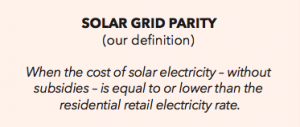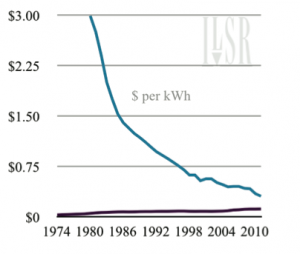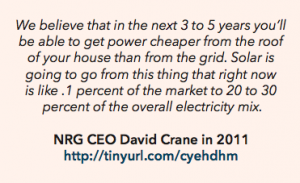The Coming Solar Electricity Transformation
Solar cells are unusual in that they were cost-competitive from the get-go. From the Apollo space program to highway signs to lighting for buoys, solar could replace highly expensive power from batteries or other sources and eliminate the need for the construction of electric distribution lines.1
When the Institute for Local Self-Reliance was founded in 1974, the first factory producing solar cells for terrestrial applications had just opened in Gaithersburg, Maryland. The cost of solar power was over $3.00 per kilowatt-hour (kWh), com- pared to $0.03 per kWh for grid electricity. The output from that factory the first year was sufficient to power only a few dozen homes.
By the late 1980s, the price of solar was low enough that solar cells were finding their way to second homes and remote cabins off the grid. In 1990, the total installed capacity of solar was 200 megawatts (worldwide, with about 25% in the U.S.), sufficient to power 4,000 homes.1 During the ensuing decade, federal and later state incentives for solar ushered in the era of grid-connected solar. By 1999, grid connected solar projects exceeded non-grid applications.
This is the first of five parts of our Rooftop Revolution report being published in serial. Download the entire report and see our other resources here.
By 2000, sufficient solar cells were installed to power 135,000 homes (with just over 20% in the U.S).2 The cost of solar was $0.50 per kWh, equivalent to an installed cost of approximately $10 per Watt. Since 2000, solar electricity production has grown exponentially. The annual installed solar capacity first exceeded 1 gigawatt (GW = 1,000 MW) in 2002 (globally).
Cost of Residential Solar v. U.S. Residential Retail Electricity Price (Nominal)
By the end of 2010, installed solar capacity in the U.S. alone exceeded 2.5 GW (sufficient to power 400,000 homes) and global capacity was over 40 GW, sufficient to power 8 million homes. Annual solar module production exceeded 30 GW worldwide.3
As production has increased the cost of solar has fallen. Since 2006, the cost of solar has dropped by 58% – 10% per year.4 Grid connected solar is on the verge of becoming competitive – without incentives – with conventional electricity.
In 1974, solar electricity cost more than 100 times the residential retail electricity rate, today the differential is 2 times or less in many communities.
 Chip in a few dollars a month to help support independent cleantech coverage that helps to accelerate the cleantech revolution!
Chip in a few dollars a month to help support independent cleantech coverage that helps to accelerate the cleantech revolution!
A Grid with Solar Parity
The policy and on-the-ground implications of “solar grid parity” are enormous. Even though solar still generates less than one-tenth of 1 percent of the nation’s electricity, public officials, towns and businesses and households will soon have a newly cost-competitive and widespread energy source to develop their own power supply. Locally produced electricity will offer an unprecedented opportunity to connect electricity production with local jobs and economic development.
The opportunity of solar grid parity will also threaten the fundamental nature of a 20th century electricity system. Utilities will have to rethink their role in the electricity network when electricity can be generated by anyone and owned by anyone. No longer will the paradigm of centralized power generation, ownership and distribution make sense when electricity can be economically produced at or near most homes and businesses. Even the concept of backing up solar power is poised to change, as electric vehicles have begun to enter garages and driveways and parking lots, adding a potentially vast number of tiny backup plants and storage systems that will have to be integrated into the grid system.
The nearness of solar grid parity brings urgency to the discussion of electricity policy, from incentives to grid design. Well before any new fossil fuel power plants have passed their infancy, electricity from solar will be cheaper. It means that policies that continue to subsidize a centralized grid and its attendant infrastructure may cost ratepayers for decades. It means that citizens and their elected leaders will have to carefully consider the policies that guide investment in the electricity system.

This report discusses a nation on the verge of widespread expansion of decentralized electricity generation and on the cusp of a new electricity system that enables more of us to produce the electricity that we consume. We identify the first American cities where solar will be competitive without incentives and estimate the amount of competitive solar that can be generated over the next decade. We discuss the implications of this massive introduction of solar and the urgency of crafting public policy that will support the transition to solar power while maintaining a balanced and reliable grid. We examine the opportunity of redirecting solar incentives – like the 30% tax credit – toward new methods of accelerating solar development that can continue to drive down the cost of solar electricity in ways that can fundamentally change our electricity system for the better.
References
- We assume that 1 MW of solar can supply approximately 200 energy efficient homes with annual electricity consumption of approximately 6250 kilowatt-hours.
- Trends in Photovoltaic Applications. (International Energy Agency, August 2010). Accessed 12/20/11 at http://tinyurl.com/bsdr94c.
- Renewable Energy Focus staff. Solar PV module capacity outpaces demand. (Renewable Energy Focus.com, 1/7/11). Accessed 1/18/12 at http:// tinyurl.com/5wjjotx.
- Preisindex Photovoltaik / Photovoltaic Price Index. (Bundesverband Solarwirtschaft / German Solar Industry, 2011). Accessed 12/20/11 at http://ti- nyurl.com/bohx52d.
Have a tip for CleanTechnica? Want to advertise? Want to suggest a guest for our CleanTech Talk podcast? Contact us here.
Latest CleanTechnica.TV Video

CleanTechnica uses affiliate links. See our policy here.


